Mathematical Perspectives of Gravitation beyond the Vacuum Regime
Because of the current health crisis, we have decided to postpone the thematic programme with the same title scheduled for February 1 to March 12, 2021 to an ulterior date. As a warm-up we present a series of online talks in the week February 22 - 26, 2021.
Purpose of the workshop:
The main aim of the workshop is to drive progress by connecting researchers working on different matter models and by advertising open problems that can serve as an entry point for researchers from other areas. In particular, we want to bring together people who work on {different types of }relativistic matter with {each other and with }those who work on non-relativistic matter. We believe large benefits are to be gained from increased interactions that would hopefully lead to exchanges of ideas and techniques that could be used to spur progress on outstanding problems in both areas.
The program is supported by the Faculty of Physics of the University of Vienna and Chalmers University of Technology.
The final schedule is online. Note that some of the lectures are available on the youtube channel of the ESI.
List of speakers and talks
Ellery Ames (Humbolt U.): Stability of Axisymmetric Stationary Einstein-Vlasov Bodies
Léo Bigorgne (Cambridge U.): Stability of Minkowski spacetime for the massless Einstein-Vlasov system
Simone Calogero (Chalmers): On self-gravitating polytropic elastic balls
Mahir Hadžić (U. College London): Instability of selfgravitating galaxies and stars
Alexandru Ionescu (Princeton U.): On the global regularity for the Einstein-Klein-Gordon coupled system
Fatima-Ezzahra Jabiri (Paris Sorbonnes U.): On stationary black hole solutions of the Einstein-Vlasov system
Juhi Jang (U. of Southern California): Dynamics of Newtonian stars
Lavi Karp (Braude): The continuity of the flow map with applications to Euler-Poisson equation
Jonathan Luk (Stanford U.): High-frequency limit in general relativity and a conjecture of Burnett
Gerhard Rein (Bayreuth U.): Can galaxies oscillate?
Oliver Rinne (HTW Berlin): Dynamics of gravitational collapse in the axisymmetric Einstein-Vlasov system
Olivier Sarbach (U. Michoacana de San Nicolás de Hidalgo): Phase space mixing in an external gravitational potential
Jared Speck (Vanderbilt U.): A New Formulation of Relativistic Euler Flow: Miraculous Geo-Analytic Structures and Applications
Robert Strain (U. of Pennsylvania): On the relativistic Boltzmann equation with long range interactions
Jérémie Szeftel (Paris Sorbonnes U.): Finite time blow up for focusing supercritical NLS and compressible fluids
Sijue Wu (U. of Michigan): On the free boundary hard phase fluid in Minkowski spacetime
Abstracts:
Ellery Ames (Humbolt U.): Stability of Axisymmetric Stationary Einstein-Vlasov Bodies
Numerical investigations support the existence of axisymmetric stationary Einstein--Vlasov bodies; that is, solutions with finite mass and compact support. A conjecture going back to Zel'dovitch, Novikov, and others states that along a parameterized sequence of such bodies, the members become unstable at the maximum of the binding energy. In this talk I will present results of our recent numerical investigations into this conjecture in the axisymmetric setting, as well as results on the dynamics of perturbed stationary states.
Léo Bigorgne (Cambridge U.): Stability of Minkowski spacetime for the massless Einstein-Vlasov system
In this talk I will present the main ideas of our proof of the stability of Minkowski spacetime for the massless Einstein-Vlasov system with non-compactly supported initial data. In particular, we will see how to differentiate the solutions in order to preserve the null structure of the equations and how to take advantage of it. I will also present certain hierarchies in the commuted equations and how to use them in order to deal with the slow decay rate of the metric. A similar result was proved by M. Taylor under a compact support assumption on the Vlasov field. This is joint work with David Fajman, Jérémie Joudioux, Jacques Smulevici and Maximilian Thaller.
Simone Calogero (Chalmers): On self-gravitating polytropic elastic balls
In this talk I will introduce a new four-parameters family of constitutive functions for spherically symmetric elastic bodies which extends the two-parameters class of polytropic fluid models widely used in several applications of fluid mechanics. The four parameters in the polytropic elastic model are the adiabatic index, the bulk modulus, the shear parameter and the Poisson ratio. The two-parameters class of polytropic fluid models arises as a special case when the Poisson ratio equals 1/2. In contrast to the standard Lagrangian approach in elasticity theory, the polytropic elastic model is formulated directly in physical space, which is particularly useful for the applications e.g. to astrophysics where the reference state of the bodies of interest (stars, planets, etc.) is not observable. After discussing some general properties of the polytropic elastic model, I will present some numerical and analytical results on steady states and the homologous motion of a polytropic elastic ball interacting with its own self-generated Newtonian gravitational field.
Mahir Hadžić (U. College London): Instability of selfgravitating galaxies and stars
Radial finite mass and compactly supported steady states of the asymptotically flat Einstein-Vlasov and Einstein-Euler systems represent isolated self-gravitating stationary galaxies and stars respectively. Upon the specification of the equation of state, such steady states are naturally embedded in 1-parameter families of solutions parametrised by the size of their central redshift. In the first part of the talk we prove that highly relativistic galaxies/stars (the ones with high central redshift) are linearly unstable (joint work with Zhiwu Lin and Gerhard Rein). This is consistent with an instability scenario suggested in 1960s by Zeldovich et al. in the Vlasov case, and Wheeler et al. in the Euler case. In the second part of the talk we explain and prove the Turning Point Principle for the Einstein-Euler system, proposed by Wheeler et al. (joint work with Zhiwu Lin).
Alexandru Ionescu (Princeton U.): On the global regularity for the Einstein-Klein-Gordon coupled system
In joint work with Benoit Pausader we consider the Einstein field equations of General Relativity for self-gravitating massive scalar fields (the Einstein-Klein-Gordon system). Our main results concern the global regularity, modified scattering, and precise asymptotic analysis of solutions of this system with initial data in a small neighborhood of the Minkowski space-time.
Fatima-Ezzahra Jabiri (Paris Sorbonnes U.): On stationary black hole solutions of the Einstein-Vlasov system
First of all, I will present a method of constructing solutions to the Einstein-Vlasov system under stationarity and spherical symmetry assumptions. These solutions have the property that the spatial support of the matter is a finite, spherically symmetric shell located away from the black hole . To this end, I will start by reviewing some of the progress made in the context of solutions to the Einstein-Vlasov system. Then, I will explain how the study of trapped timelike geodesics in a perturbed Schwarzschild spacetime allowed us to provide one-parameter family of solutions.
The second part of the talk is dedicated to the generalisation of the above method to obtain stationary and axisymmetric black hole solutions.
Juhi Jang (U. of Southern California): Dynamics of Newtonian stars
A classical model to describe the dynamics of Newtonian stars is the gravitational Euler-Poisson system. The Euler-Poisson system admits a wide range of star solutions that are in equilibrium or expand for all time or collapse in a finite time or rotate. In this talk, I will discuss some recent progress on those star solutions with focus on expansion and collapse. The talk is based on joint works with Yan Guo and Mahir Hadzic.
Lavi Karp (Braude): The continuity of the flow map with applications to Euler-Poisson equation
Though there are numerous results for the existence and uniqueness of Euler-Poisson equations in various situations, surprisingly, the continues depending on the initial data has not been established so far. In a recent joint work with U. Brauer we proved the continuity of the flow map for symmetric hyperbolic systems and we applied it to Euler-Poisson equation. Previously, the continuous depending on the initial data for symmetric hyperbolic was proved by Kato, our method is based upon a new type of energy estimates. This method will enable us to apply it for relativistic flows, including non-isentropic flows.
Jonathan Luk (Stanford U.): High-frequency limit in general relativity and a conjecture of Burnett
It is known in the literature that ”high-frequency weak limits” of solutions to the Einstein vacuum equations are not necessarily vacuum solutions, but may have a non-trivial stress-energy-momentum tensor, which can be viewed physically as ”effective matter fields” arising from back-reaction of high-frequency gravitational waves. Burnett conjectured nonetheless that any such limit is isometric to a solution to the Einstein-massless Vlasov system; and conversely that any solution to the Einstein-massless Vlasov system arises as such limit. We discuss some recent progress on Burnett’s conjecture, as well as an application of it. This talk is based on joint works with Huneau, and with Rodnianski.
Gerhard Rein (Bayreuth U.): Can galaxies oscillate?
The above question is one aspect of the following, more general question: Given a self-gravitating matter distribution in equilibrium, what happens to it after a small perturbation? The first issue to address here is stability or instability. But once the equilibrium configuration (steady state) is known to be stable or unstable, a small perturbation may still trigger qualitatively very different dynamics: In the unstable case, the solution may collapse or disperse (or...), in the stable case it may (in some sense) converge back to the steady state or it may oscillate around it forever (or...). In my talk I will consider these issues in the context of the Vlasov-Poisson and Einstein-Vlasov systems, PDE-systems which are used to model galaxies. After a review of the general context I will discuss results towards the question in the title, which originate from joint work in progress with Mahir Hadzic and Christopher Straub, and which also bear on the question of Landau damping for isolated, self-gravitating systems.
Oliver Rinne (HTW Berlin): Dynamics of gravitational collapse in the axisymmetric Einstein-Vlasov system
We numerically investigate the dynamics near black hole formation of solutions to the Einstein-Vlasov system in axisymmetry. A symmetry reduction of the Einstein-Vlasov equations in the (2+1)+1 formalism is performed, including rotation. The numerical implementation is based on a constrained (mixed hyperbolic-elliptic) evolution scheme. The collisionless matter is treated using a particle-in-cell method. We tune smooth one-parameter families of initial data to the threshold of black hole formation and observe type I critical behaviour, in particular power-law scaling of the lifetime of the near-critical solution. The qualitative behaviour close to the critical point is found to depend on the sign of the binding energy. We prove that complete dispersal of the solution implies that it has nonpositive binding energy. This is joint work with Ellery Ames and Håkan Andréasson.
Olivier Sarbach (U. Michoacana de San Nicolás de Hidalgo): Phase space mixing in an external gravitational potential
We discuss some recent results regarding the dynamics of a collisionless kinetic gas which is trapped in a rotationally symmetric potential well. Although at the microscopic level the trajectories of individual gas particles are quasi-periodic and characterized by their fundamental frequencies, at the macroscopic level the gas relaxes in time to a stationary state, provided the potential satisfies a certain non-degeneracy condition. In this talk, we will provide a mathematically precise formulation for this relaxation process and will show that it is due to phase space mixing. In particular, we prove that a physically relevant class of macroscopic observables computed from the one-particle distribution function, such as particle and energy densities, pressure and stress tensors, converge in time to the corresponding observables associated with an averaged distribution function. The latter can be determined from the initial datum and depends only on integrals of motion. Some applications to gravitational physics will be presented, including: (i) the propagation of a collisionless gas in typical potentials arising in stellar dynamics and the modeling of dark matter halos, (ii) the propagation of a relativistic kinetic gas whose individual particles follow bound timelike trajectories in the exterior region of a black hole spacetime.
Based on joint work with Paola Rioseco (arXiv:2005.05988, arXiv:1807.10794).
Jared Speck (Vanderbilt U.): A New Formulation of Relativistic Euler Flow: Miraculous Geo-Analytic Structures and Applications
I will discuss my recent joint work with M. Disconzi on the relativistic Euler equations with non-trivial vorticity and entropy. We derived a new formulation of the equations exhibiting miraculous geo-analytic structures, including I) A sharp decomposition of the flow into geometric "wave parts'' and "transport-div-curl parts;" II) Null form source terms; and III) Structures that allow one to propagate one additional degree of differentiability (compared to standard estimates) for the entropy and vorticity. We were inspired to search for such a formulation by Christodoulou's groundbreaking 2007 monograph on shock formation in irrotational and isentropic regions and by related work on the non-relativistic compressible Euler equations. I will then describe how the new formulation can be used to derive sharp results about the dynamics, including results on stable shock formation and the existence of low-regularity solutions. I will emphasize the role that nonlinear geometric optics plays in the framework and highlight how the new formulation allows for its implementation. Finally, I will connect the new formulation to the broader goal of obtaining a rigorous mathematical theory that models the long-time behavior of solutions that can develop shocks.
Robert Strain (U. of Pennsylvania): On the relativistic Boltzmann equation with long range interactions
In this talk I will discuss three recent related results regarding the special relativistic Boltzmann equation without angular cutoff. In the non-relativistic situation without angular cutoff, the change of variables from v \to v' is a crux of the widely used "cancellation lemma". In a first result, in collaboration with James Chapman and Jin Woo Jang, in the special relativistic situation we calculate this very complex ten variable Jacobian determinant and illustrate some numerical results which show that it has a large number of distinct points where it is machine zero. In a second result, in collaboration with Jang, we prove the sharp pointwise asymptotics for the frequency multiplier of the linearized relativistic Boltzmann collision operator that has not been previously established. As a consequence of these calculations, we further explain why the well known change of variables p \to p' is not well defined in the special relativistic context. The third result, also in collaboration with Jang, I will explain our recent proof of global-in-time existence, uniqueness and asymptotic stability for solutions nearby the relativistic Maxwellian to the special relativistic Boltzmann equation without any angular cutoff. We work in the case of a spatially periodic box. We assume the generic hard-interaction and soft-interaction conditions on the collision kernel that were derived by Dudyński and Ekiel-Jeżewska (in 1985). In this physical situation, the angular function in the collision kernel is not locally integrable, and the collision operator behaves like a fractional diffusion operator. This is the first global existence and stability result for relativistic Boltzmann equation without angular cutoff.
Jérémie Szeftel (Paris Sorbonnes U.): TBA
Sijue Wu (U. of Michigan): On the free boundary hard phase fluid in Minkowski spacetime
In this talk I will explain some of the basic ideas involved in proving the well-posedness of the Cauchy problem of a class of fluid free boundary problems. I will then present a result on the wellposedness of a barotropic fluid free boundary problem in Minkowski spacetime. This is a joint work with Shuang Miao and Sohrab Shahshahani.
Instability of selfgravitating galaxies and stars
On the relativistic Boltzmann equation with long range interactions
A New Formulation of Relativistic Euler Flow: Miraculous Geo-Analytic Structures and Applications
Dynamics of Newtonian stars
Stability of Minkowski spacetime for the massless Einstein-Vlasov system
On the global regularity for the Einstein-Klein-Gordon coupled system
In joint work with Benoit Pausader we consider the Einstein field equations of General Relativity for self-gravitating massive scalar fields (the Einstein-Klein-Gordon system). Our main results concern the global regularity, modified scattering, and precise asymptotic analysis of solutions of this system with initial data in a small neighborhood of the Minkowski space-time.
Phase space mixing in an external gravitational potential
High-frequency limit in general relativity and a conjecture of Burnett
It is known in the literature that ”high-frequency weak limits” of solutions to the Einstein vacuum equations are not necessarily vacuum solutions, but may have a non-trivial stress-energy-momentum tensor, which can be viewed physically as ”effective matter fields” arising from back-reaction of high-frequency gravitational waves. Burnett conjectured nonetheless that any such limit is isometric to a solution to the Einstein-massless Vlasov system; and conversely that any solution to the Einstein-massless Vlasov system arises as such limit. We discuss some recent progress on Burnett’s conjecture, as well as an application of it. This talk is based on joint works with Huneau, and with Rodnianski.
The continuity of the flow map with applications to Euler-Poisson equation
Finite time blow up for focusing supercritical NLS and compressible fluids
I will present recent results in collaboration with Frank Merle, Pierre Raphaël and Igor Rodnianski concerning finite time blow up
for the defocusing supercritical NLS equation, for compressible Euler equations, and for compressible Navier-Stokes equations.
On self-gravitating polytropic elastic balls
On the free boundary hard phase fluid in Minkowski spacetime
In this talk I will explain some of the basic ideas involved in proving the well-posedness of the Cauchy problem of a class of fluid free boundary problems. I will then present a result on the wellposedness of a barotropic fluid free boundary problem in Minkowski spacetime. This is a joint work with Shuang Miao and Sohrab Shahshahani.
On stationary black hole solutions of the Einstein-Vlasov system
First of all, I will present a method of constructing solutions to the Einstein-Vlasov system under stationarity and spherical symmetry assumptions. These solutions have the property that the spatial support of the matter is a finite, spherically symmetric shell located away from the black hole . To this end, I will start by reviewing some of the progress made in the context of solutions to the Einstein-Vlasov system. Then, I will explain how the study of trapped timelike geodesics in a perturbed Schwarzschild spacetime allowed us to provide one-parameter family of solutions.
The second part of the talk is dedicated to the generalisation of the above method to obtain stationary and axisymmetric black hole solutions.
Can galaxies oscillate?
The above question is one aspect of the following, more general question: Given a self-gravitating matter distribution in equilibrium, what happens to it after a small perturbation? The first issue to address here is stability or instability. But once the equilibrium configuration (steady state) is known to be stable or unstable, a small perturbation may still trigger qualitatively very different dynamics: In the unstable case, the solution may collapse or disperse (or...), in the stable case it may (in some sense) converge back to the steady state or it may oscillate around it forever (or...). In my talk I will consider these issues in the context of the Vlasov-Poisson and Einstein-Vlasov systems, PDE-systems which are used to model galaxies. After a review of the general context I will discuss results towards the question in the title, which originate from joint work in progress with Mahir Hadzic and Christopher Straub, and which also bear on the question of Landau damping for isolated, self-gravitating systems.
Dynamics of gravitational collapse in the axisymmetric Einstein-Vlasov system
Stability of Axisymmetric Stationary Einstein--Vlasov Bodies
Organizers
| Name | Affiliation |
|---|---|
| Håkan Andréasson | Chalmers University of Technology |
| David Fajman | University of Vienna |
| Jérémie Joudioux | Max Planck Institute for Gravitational Physics |
| Todd Oliynyk | Monash University |
Attendees
| Name | Affiliation |
|---|---|
| Peter C. Aichelburg | University of Vienna |
| Ellery Ames | Humbolt State University |
| Nikolaos Athanasiou | Imperial College London |
| Hamed Barzegar | University of Vienna |
| Robert Beig | University of Vienna |
| Léo Bigorgne | University of Cambridge |
| Volker Branding | University of Vienna |
| Uwe Brauer | Universidad Complutense de Madrid |
| Annegret Burtscher | Radboud University |
| Simone Calogero | Chalmers University of Technology |
| Xuantao Chen | Johns Hopkins University |
| Piotr T. Chruściel | University of Vienna |
| Armand Coudray | University of Brest |
| Marcelo Disconzi | Vanderbilt University |
| Roland Donninger | University of Vienna |
| Allen Fang | Sorbonne University |
| Felix Finster | Universität Regensburg |
| Joachim Frenkler | University of Bayreuth |
| Carlos Eduardo Gabarrete Fajardo | Universidad Michoacana de San Nicolás de Hidalgo, |
| Edgar Gasperin | University of Burgundy |
| Shalabh Gautam | Inter-University Center for Astronomy and Astrophysics |
| Sari Ghanem | University Lübeck |
| Elena Giorgi | Princeton University |
| Irfan Glogić | University of Vienna |
| Mateja Gosenca | University of Vienna |
| Sebastian Günther | University of Bayreuth |
| Mahir Hadžić | University College London |
| Lili He | Johns Hopkins University |
| Peter Hintz | ETH Zurich |
| Alexandru Ionescu | Princeton University |
| Fatima-Ezzahra Jabiri | University College London |
| Juhi Jang | University of Southern California |
| Jose-Luis Jaramillo | Université de Bourgogne |
| Lavi Karp | ORT Braude College |
| Joel Kurzweil | University of Vienna |
| Timo Lebeda | University of Bayreuth |
| Philippe G. LeFloch | Sorbonne University |
| Mohammed Lemou | Université de Rennes 1 |
| Jonathan Luk | Stanford University |
| Siyuan Ma | Sorbonne University |
| Maciej Maliborski | University of Vienna |
| Florian Méhats | Université de Rennes 1 |
| Filipe Mena | University of Lisbon |
| King Ming Lam | University College London |
| Marica Minucci | Queen Mary University of London |
| Mariem Magdy Ali Mohamed | Queen Mary University of London |
| Georgios Moschidis | Princeton University |
| José Natário | Instituto Superior Técnico Lisboa |
| Gustav Nilsson | Albert-Einstein-Institute |
| Brien Nolan | Dublin City University |
| Mikael Normann | Queen Mary University of London |
| Matthias Ostermann | University of Vienna |
| Johannes Oude Groeniger | KTH Stockholm |
| Shrish Parmeshwar | University of Bath |
| Oliver Petersen | Uppsala University |
| Cornelius Rampf | Ruđer Bošković Institute |
| Gerhard Rein | University of Bayreuth |
| Natascha Riahi | University of Vienna |
| Hans Ringström | KTH Stockholm |
| Oliver Rinne | HTW Berlin |
| Paola Rioseco | Universidad de Chile |
| Hannes Rueter | Albert-Einstein-Institute |
| Olivier Sarbach | Universidad Michoacana de San Nicolás de Hidalgo, |
| Bernd Schmidt | Max Planck Institute for Gravitational Physics |
| Jacques Smulevici | University Paris Sorbonnes |
| Jared Speck | Vanderbilt University |
| Robert Strain | University of Pennsylvania |
| Christopher Straub | University of Bayreuth |
| Martin Taylor | Imperial College London |
| Juan A. Valiente Kroon | Queen Mary University of London |
| Andras Vasy | Stanford University |
| Jinhua Wang | Xiamen University |
| Jörg Weber | University of Vienna |
| Max Weissenbacher | Imperial College London |
| Sijue Wu | University of Michigan |
| Zoe Wyatt | University of Cambridge |
| Xiaoyi Xie | University of Southampton |
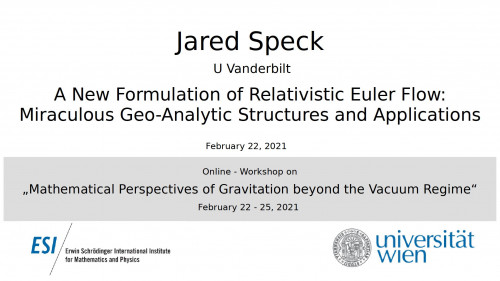
Feb. 22, 2021 16:30 — 17:30
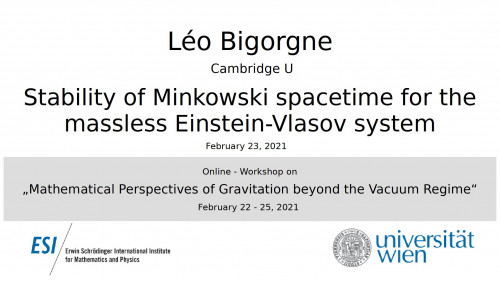
Feb. 23, 2021 14:00 — 15:00
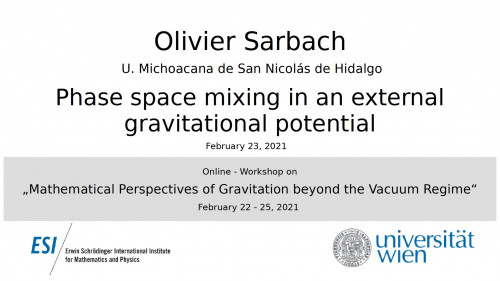
Feb. 23, 2021 16:30 — 17:30
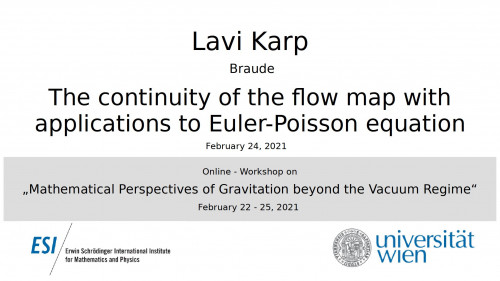
Feb. 24, 2021 14:00 — 15:00
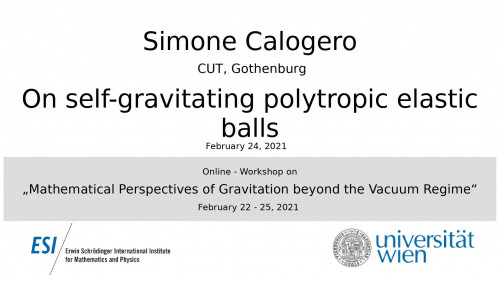
Feb. 24, 2021 16:30 — 17:30
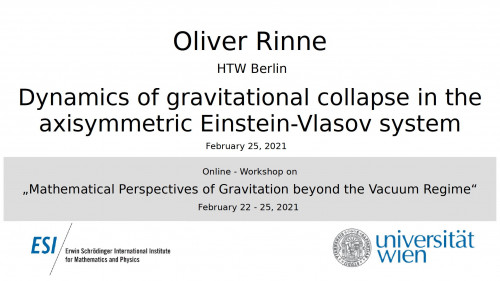
Feb. 25, 2021 16:30 — 17:30
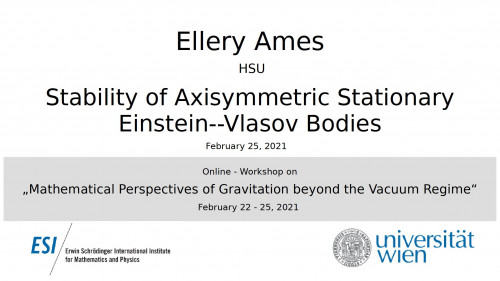
Feb. 25, 2021 17:30 — 18:30
- Type:
- Online Workshop
- When:
- Feb. 22, 2021 — Feb. 25, 2021
- Where:
- Erwin Schrödinger Institute - virtual
- Part of:
- Mathematical Perspectives of Gravitation beyond the Vacuum Regime - postponed (Thematic Programme)
- Organizer(s):
-
Håkan Andréasson (Chalmers U of Technology, Gothenburg)
David Fajman (U of Vienna)
Jérémie Joudioux (MPIGP, Potsdam)
Todd Oliynyk (Monash U, Melbourne)